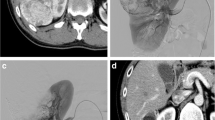Abstract
Background
The aim of this study was to evaluate the effects and the utility of second-line everolimus treatment for regrown renal angiomyolipoma (AML) with tuberous sclerosis complex (TSC) after transcatheter arterial embolization (TAE).
Methods
We investigated a total of 14 patients who underwent second-line everolimus treatment for TSC–AML that regrew after TAE, and assessed their effects and adverse events. Everolimus treatment was performed for AML with a maximum diameter of 4 cm. To determine the reduction ratio of AML, the volume of AML was measured using multislice helical computed tomography. Adverse events were evaluated according to CTCAE v4.0-JCOG. We further compared the treatment effect and adverse events with those in patients receiving first-line everolimus treatment.
Results
The AML volume decreased in all patients, with a ≥ 50% volume decrease in 57% (8 of 14) of the cases, and the mean reduction rate was 53%. We observed no significant difference in the mean reduction rate of AML between second-line everolimus treatment for regrown TSC–AML after TAE and first-line everolimus treatment for TSC–AML. The adverse events were mild and consistent with those reported in our previous study.
Conclusion
Although further studies are needed, everolimus appears to be effective as second-line treatment for TSC–AML that regrew after TAE and a beneficial treatment option for TSC–AML.



Similar content being viewed by others
References
Osborne JP, Fryer A, Webb DW (1991) Epidemiology of tuberous sclerosis. Ann NY Acad Sci 615:125–127
van Slegtenhorst M, de Hoogt R, Hermans C et al (1997) Identification of the tuberous sclerosis gene TSC1 on chromosome 9q34. Science 277:805–808
The European Chromosome 16 Tuberous Sclerosis Consortium (1993) Identification and characterization of the tuberous sclerosis gene on chromosome 16. Cell 75:1305–1315
Curatolo P, Bombardieri R, Jozwiak S (2008) Tuberous sclerosis. Lancet 372:657–658
Castagnetti M, Vezzu B, Laverda A et al (2007) Urological counseling and follow up in pediatric tuberous sclerosis complex. J Urol 178:2155–2159
Kaneda MW, Tanaka M, Hamasaki T et al. (2013) Trends in the prevalence of tuberous sclerosis complex manifestations: an epidemiological study of 166 Japanese patients. PLoS One 8:e63910
Neumann HP, Schwarzkopf G, Henske EP (1998) Renal angiomyolipomas, cysts, and cancer in tuberous sclerosis complex. Semin Pediatr Neurol 5:269–275
Rouviere O, Nivet H, Grenier N et al. (2013) Kidney damage due to tuberous sclerosis complex: management recommendations. Diagn Interv Imaging 94:225–237
Hatano T, Chikaraishi K, Inaba Y et al. (2016) Outcomes of everolimus treatment for renal angiomyolipoma with tuberous sclerosis complex: a single institution experience in Japan. Int J Urol 23:833–838
Krueger DA, Northrup H, International Tuberous Sclerosis Complex Consensus Group (2013) Tuberous sclerosis complex surveillance and management: recommendations of the 2012 International Tuberous Sclerosis Complex Consensus Conference. Pediat Neurol 48:255–265
Ewalt DH, Diamond N, Rees C et al (2005) Long term outcome of transcatheter embolization of renal angiomyolipomas due to tuberous sclerosis complex. J Urol 174:1764–1766
Rakowski SK, Winterkorn EB, Paul E et al (2006) Renal manifestations of tuberous sclerosis complex: incidence, prognosis, and predictive factors. Kidney Int 70:1777–1782
Bissler JJ, Kingswood JC, Radzikowska E et al (2013) Everolimus for angiomyolipoma associated with tuberous sclerosis complex or sporadic lymphangioleiomyomatosis (EXIST-2): a multicenter, randomized, double-blind, placebo-controlled trial. Lancet 381:817–824
Bissler JJ, Kingswood JC, Radzikowska E et al (2016) Everolimus for angiomyolipoma associated with tuberous sclerosis complex or sporadic lymphangioleiomyomatosis: extension of a randomized, controlled trial. Nephrol Dial Transplant 31:111–119
Hatano T, Atsuta M, Inaba Y, Endo K, Egawa S (2018) Effect of everolimus treatment for renal angiomyolipoma with tuberous sclerosis complex: an evaluation based on tumor density. Int J Clin Oncol 23:547–552
Yamakado K, Tanaka N, Nakagawa T, Kobayashi S, Yanagawa M, Takeda T (2002) Renal angiomyolipoma: relationships between tumor size, aneurysm formation, and rupture. Radiology 225:78–82
Kumar S, Jayant K, Singh SK, Agrawal S (2015) A case series & review of literature of angiomyolipoma with medical & surgical perspective. J Clin Diagn Res 9:PD05–PD07
Sheth RA, Feldman AS, Paul E et al. (2016) Angiographic and volumetric effects of mammalian target of rapamycin inhibitors on angiomyolipoma in tuberous sclerosis. World J Radiol 8:308–315
Sonis ST (2009) Mucositis: the impact, biology and therapeutic opportunities of oral mucositis. Oral Oncol 45:1015–1020
Ha SH, Park JH, Jang HR et al (2014) Increased risk of everolimus-associated acute kidney injury in cancer patients with impaired kidney function. BMC Cancer 14:906
Hatano T, Inaba Y, Endo K, Egawa S (2017) Intermittent everolimus administration for renal angiomyolipoma with tuberous sclerosis complex. Int J Urol 24:780–785
Krummel T, Garmon J, Lang H, Gangi A, Hannedouche T (2014) Percutaneous cryoablation for tuberous sclerosis-associated renal angiomyolipoma with neoadjuvant mTOR inhibition. BMC Urol 14:77
Park BK, Kim CK, Park SY, Shen S (2013) Percutaneous radiofrequency ablation of renal cell carcinomas in patients with von Hippel Lindau disease: indications, techniques, complications, and outcomes. Acta Radiol 54:418–427
Author information
Authors and Affiliations
Corresponding author
Ethics declarations
Conflict of interest
The authors of this article declare no conflict of interest.
About this article
Cite this article
Hatano, T., Matsu-ura, T., Mori, Ki. et al. Effect of everolimus treatment for regrown renal angiomyolipoma associated with tuberous sclerosis complex after transcatheter arterial embolization. Int J Clin Oncol 23, 1134–1139 (2018). https://doi.org/10.1007/s10147-018-1325-0
Received:
Accepted:
Published:
Issue Date:
DOI: https://doi.org/10.1007/s10147-018-1325-0




